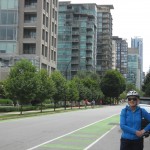
Vancouver’s West End
Wrap up
This will be a final wrap-up for the major trip Colette and I have been on these last four months.
We’ve been back in New Zealand from our trip now for about ten days. We left on June 3rd for the U.S. where we spent a month touring up and down the west coast seeing friends and family. We traveled from Orange County, on the south, to Vancouver, B.C., on the north. I’ve done this trip four times now and this was Colette’s 2nd go-round. All the cross country driving is fun.
U.S. West Coast

Benicia lunch with Dave
We saw a ton of stuff and the especially good bits, other than the friends and family we saw (smile), were Las Vegas, Yosemite and Vancouver, B.C. We’re especially pumped about the city of Vancouver and it is on our list for next year’s live-in immersion adventure; along with Montreal.
My head is spinning as I’m reflecting on and remembering all the places we’ve been in these last four months.
From the U.S., we flew July 1st to Frankfurt, Germany and then onto Paris; arriving on the 2nd.
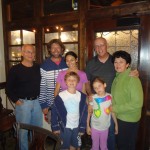
Family in Irvine
It wasn’t going to be a smooth trip, as we discovered, when we left my friend Dave’s house, bound for the BART station where we were going to catch a train to San Francisco Airport. It turned out that we had chanced to try our travel on the very day of the first BART strike in 16 years and BART train stations all across the Bay Area were shuttered.
After the initial shock of learning this for all of us, Dave stepped up to the plate and said he’d drive us all the way into the airport and off we went with our only guide; his GPS. That little guide was, itself, a gamble as he hadn’t brought its charger so it was running on batteries and none of us had any idea how much juice it had left. If it died on the way, we’d be lost and we’d be toast.
But it lasted, thanks to the God of small batteries, and we arrived in time. And, with profuse thanks to our host and transporter, Dave, for his hospitality and for being willing to drive us all the way into the airport with zero notice, we took leave of him to catch our flight.
Away to Paris
A flight which, as it turned out, was an hour late taking off from San Francisco. Which meant that later, when we arrived in Frankfurt, we then failed to make the connection with our Paris flight to Charles de Gaulle airport. Ah my, it was, indeed, a day of travel problems.
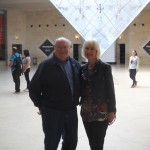
Gerry and Colette at the Louvre
Our Parisian friend, Gerry, was waiting for us in Paris at Charles de Gaulle and he managed to work out what probably had happened to us when we didn’t get off the expected plane. So, bless him, he stayed around for the next plane, which we were on, and all was well; though we were a bit frazzled after all of that fun.
And then began three months in Paris as Gerry’s guest in his extra apartment.
That was, indeed, a beautiful and very special time for us. But, since I’ve already written extensively on our adventures in Paris, I’m not going to wax on further here about that. Instead, I’m going to press on to describe the last part of our trip; which was Singapore.
We departed Paris for Singapore on September 30th and, after an overnight flight, we arrived in Singapore on October 1st.
And on to Singapore
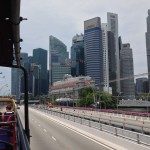
Singapore Skyline
It’s hard for me to recall what I expected from visiting Singapore. When we booked, it was just a place I’d heard of that we were going to pass through on the way home to Christchurch. But, since I’d never been there, we decided to lay over for the better part of a week and have a look around. Really, at the time we booked it, it was nothing more than idle curiosity on my part. Colette had been there once before years earlier and said it was nice; though hot.
Well, it is not an exaggeration to say that the place really knocked my socks off.
Singapore is one of the wonders of the modern world in many ways. If you don’t get anything else out of reading this, treat yourself and go read the Wikipedia article about Singapore here. You will learn a lot that will surprise you, I expect.
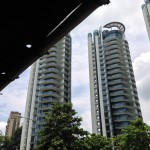
High-rise Apartments
The first thing we noticed was the intense urban feel of the place and the high rise apartment and business buildings in all directions.
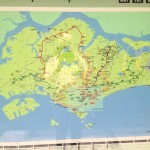
Singapore Island and Metro System
There are four to five million people living here on a small island that is at the southern tip of the Malay Peninsula. The main island is approximately 42km east to west and 23 km north to south. Or, in miles, it is 31 by 19. There are, as well, a number of smaller islands but only one big one.
Weather? It is very hot and humid as you are just slightly north of the equator.
I’d heard about the cleanliness of the place but, still, it is something to see. No trash, no gum blobs on the sidewalks, Metro trains that run smooth as silk and a mixed racial population that seems to get on very well. There’s feeling of prosperity in the air in the dense central city areas of the eastern end of the island where we began our explorations.
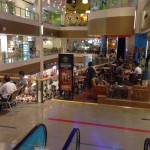
Another Shopping Mall
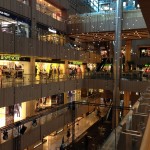
Shopping Mall

Colette finds ‘her’ store
Walking down the main shopping road; Orchard Road, you could easily imagine yourself back in Paris. All the big fashion names are there. And you will find shopping mall after shopping mall; each one more amazing than the last in its architecture.

Beating the hea
On the first day, we went out and walked a lot but I found that really tiring. The heat was like a hammer and the difference between being in the sun or the shade was huge. And shade was hard to come by at mid-day because the sun was straight overhead.
After I was throughly hot and miserable (Colette had an umbrella so she handled all of this better than I did), we finally found a nice cafe with shade and settled in for an afternoon beer and some relaxed people watching and I began to recover a bit.
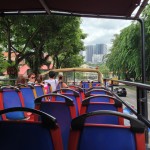
Double-decker bus touring
The next day, we were smarter. We found out that for $18 Singaporean each, you could ride a city double-decker tour bus and get on and off as you liked for the entire day. It went around the most interesting and dense areas of the city on the eastern end of the island and it came by every 30 minutes.
So, we did this. In the morning we got on and sat on the right side of the bus and went all the way around the loop just looking and talking and taking pictures. It took about two and a half hours.
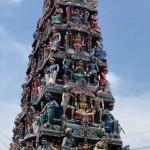
Hindu Temple

In the heat of the day
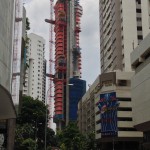
Building everywhere
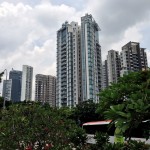
High-rise Apartments
Then, we got off on Orchard Road and wandered until we found a nice lunch place and then, after a short rest, we got back on the bus again. And this time, we sat on the left side and went all the way around again. It was well worth the money and we saw a ton of things without having to suffer and sweat in the tropical sun.
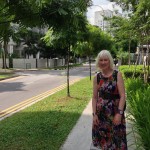
The street to our Hotel
The five evenings we were there, we mostly followed the same pattern and ate at the restaurant on the ground floor of our hotel. By that time of day (6 or 7pm), the temperature was nice and sitting outside was a great pleasure. We sat outside and ate slowly and watched the traffic and the people passing by and discussed all that we’d seen during the day.
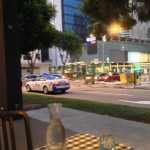
Singapore evening meal
Genesis of Singapore
For me, there was a lot more to Singapore than the glossy surfaces we were seeing. In odd moments, I delved into reading about it and learning how the place came to be; and it was a fascinating story.
In a nutshell, Singapore, Malaysia and other former colonies of Britain in the area came together to form a new Malaysian Federation in 1963.
At that time, Singapore had been a long time British colony and had a thriving harbor and was a regional trade center. But it was also an uncomfortably hot tropical place where most folks lived in poverty, corruption was the rule, squalor was everywhere and there was a lot of racial disharmony.
The new union of Singapore and Malaysia was an uneasy one from the beginning and the issues were mostly racial.
Malaysia wanted to pass laws making the Malaysian people the first among equals to keep them ascendant over the Chinese.
The folks on Singapore strongly favored the alternative idea that all races should have equal rights. Singapore today is 75% or better Chinese and it was probably a similar mixture back then.
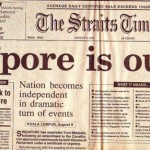
Singapore’s birth
There was a lot a strife over all this and the situation looked like it might evolve into a civil war. But Malaysia acted preemptively and ejected Singapore by a unanimous vote from the Federation in 1965.
And at that point, Singapore found itself, by surprise, as an island city-state and as a newly minted nation.
The first years were quite scary, I think, as SIngapore could have easily been subsumed into Indonesia or reabsorbed back into Malaysia under less than optimal conditions in either case.
But, they were lucky in that they had a leader named Lee Kuan Yew. He was a take-charge fellow and a visionary and he took Singapore in hand and began to mold it.

Lee Kuan Yew
And this molding wasn’t of the standard dictatorial militaristic take-all-the-money, bank it and suppress any dissent type. No, it was a beneficent moulding. Yew’s motives, so far as I can see from reading history and by looking around me, were to shape the place for the good of the people.
This doesn’t mean he was a Communist or a Socialist. He was a Capitalist; but one of a different sort than seems to predominate in the world today.
He believed in using the power of business to raise the living standards of his people. I believe he saw Capitalism as a tool but he also saw, that as a tool, it must always remain subordinate to the greater goal; which was “the good of the people”.
In my opinion, what’s where most of us in Capitalist countries have deeply lost the plot. We’ve never established that the highest goal of our countries should be to maximize the quality of life for all of the country’s citizens. And, not having made that decision, we’ve left a vacuum into which others have rushed to promote the supremacy of their visions of personal wealth, of political power, of corporate domination and on and on. In the absence of clear priorities, the pushiest and the greediest find their ways to the front of the bus.
Within 10 years Yew had rehoused most of Singapore’s population in high rise apartment buildings.
Early on. he passed laws with real teeth against graft and corruption; laws that were actually enforced at all levels.
He declared that English would the first language of the land (though everyone could and did have a second language of choice which they were free to us).
He mandated racial equality and built support for it into the school curriculums to teach it at every level.
He poured a large amount of the nation’s wealth into housing, into their military (modeled after the West German and Israeli models), into education and into transport (busses and Metro) and into communications needs.
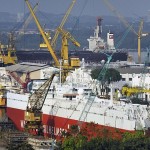
Ship Building
He realized the value of having a diversified economy and he moved Singapore into many types of business that were new to it and he did this very successfully.
He made the price of owning cars so prohibitive that today only one person in 10 in Singapore owns one.
He promoted Singapore’s involvement in finance and Singapore today is one of the world’s largest financial centers.
But it has to be said that the Singaporean government is essentially a benevolent dictatorship in spite of having a multiparty parliamentary system.
Yew ruled from independence in 1965 until 1990, Then a protégé of his, Goh Chok Tong, ruled from 1990 to 2004. And then Yew’s eldest son, Lee Hsien Loong, took over and he still rules today. So, it’s been very much a dynasty with a controlled succession.
They allow multiple parties in Singapore but the party Yew was part of, the People’s Action Party (PAP), has won every election since the country was founded. And of all the seats in the legislature, the vast majority have always gone to PAP candidates.
That sounds like it could be a dismal situation, politically, but in fact the results say otherwise.
People in Singapore live well. 80 to 90% own their own homes. They are an enormously well educated bunch and the per capita wealth level is very high (third highest in the world).
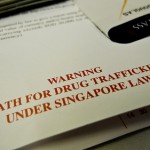
Death for drugs
There is a hard side to the place, however, but maybe its not so bad. If you spit on the sidewalk or throw trash, you can get a major fine. And if you bring drugs into the country, they will simply execute you.
There’s a lot of superlatives about the place.
Singapore is the world’s fourth largest financial centre.
Its harbor is one of the busiest in the world (it is the fifth largest).
Singapore is one of the four ‘Asian Tiger” nations.
Democracy – are we smart enough?
All of this information made me quite reflective as we wandered around. In thinking about Singapore being a beneficent dictatorship, I remembered what Churchill had to say about Democracy:
“Democracy is the worst form of government, except for all those other forms that have been tried from time to time.”
I reflect on this saying a lot because I’m not convinced people in general are smart enough for the responsibility of participating in a democracy. But, on the other hand there’s very little to be said for Communism or dictatorships either.
So Singapore, for me, was a bit of a revelation because it represents another possibility; a third way.
A way in which power is gathered at the top and wielded sincerely for the good of the people being governed rather than for the good of those who govern (as in dictatorships) or for the good of the wealthy (as in the case of many western democracies today).
You may say that Singapore is a very rare and special case and could not exist except for the small size of the place and the remarkable circumstances of its birth. And I would have to agree; it is remarkable and it is probably not a pattern we will see often; no matter how admirable it might be.
The way they were and how they changed
Racial tension was a part of the early Singapore. Today, Singapore is 75% Chinese and most of the rest is made of up Malays and Indians with an odd smattering of Europeans. But the melding is working.
The government helps to make it work in an intelligent manner. For example, each apartment building, as the units are sold, is supervised to make sure that the racial mixes of the apartments agrees with the racial mix of the country. School programs actively structure things so that everyone get a good look inside the cultures of the other groups in Singapore as they grow up. The government works actively to diffuse enclaves of different racial groups from forming in the different neighborhoods; with the exception of Chinatown and Little India which are grandfathered in.
Anyway, all of this was background for me as we wandered around and looked at the place. Reading the newspapers and absorbing the evening news fascinated me daily as I looked to see if the place seemed like it was really working as well as it claimed to. And for me, it looked like it really was.
Chinatown and Little India
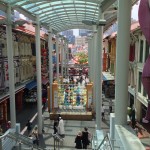
Chinatown Delux
The day after the big bus tour, we went to Chinatown and then onto Little India; both of which are special enclaves within the city which survive from pre-independence days. We walked and looked and shopped. Colette bought a pair of pants she loved for $6 Singaporean; which was a serious steal.
In Chinatown, we saw a very beautiful Buddhist Temple.
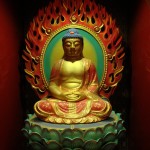
In the Buddhist Temple
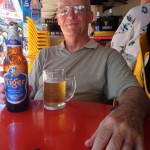
A man and his beer
At one point in Chinatown, we sat in a side street cafe outside (but shaded) for a long time while I imbibed a 660 ml Tiger beer and we people watched. Yum.
Then, in Little India, we found a lot of fun and amazing things; including an upstairs clothing sales area that was absolutely chock-a-block with tens of thousands of Indian dresses of every description. If you couldn’t find it here, you were not going to find it.
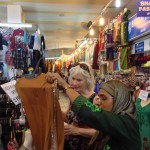
Colette does the shop
Then we sat down in a large courtyard surrounded by little food stalls selling all sorts of ethnic dishes and I had a coke and we just watched it all flow by; contentedly.
Life for the average man and women
On the last full day, we did a favorite things of ours.; we got on the Metro and bought a ticket to the end-of-the-line and went all 30 miles or so to the western end of the island – just to see what was there.
And along the way, it was something to see. Mile after mile of high rise apartment buildings of all sorts of vintages all the way back the the first one built in the late 60’s. These were intermixed with industrial areas and off in the far distances, I could see huge cranes and I recalled reading that Singapore is a major ship building and repairing port as well.
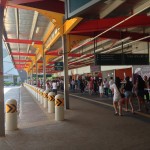
Metro Train Station
Periodically, at the train stations, there would be huge shopping centers. Really, these were small cites in their own right.
And, beside the larger train stations would be huge parking lots exclusively for busses by the dozens which would carry people to the north and south of the Metro line to and from their apartment homes or their work.
Along the tracks, in addition to the high rises and industrial areas, were nice parklands as well. Singapore has dedicated 5% of itself to parklands. But of native bush there wasn’t much to be seen. Truly, the Singaporeans have nearly filled their island and the only way for them is up.
We rode to the far end of the East/West line to a place called, “Joo Koon”. And it really was the end of the line.
There was a fair amount of industrial stuff scattered around but not much in the way of high rise housing there. We came on a Sunday so it was pretty quiet. A few locals stared at us and we couldn’t find a any place to get a cup of coffee or to wander and shop a bit so we got back on the train and headed east again after 15 minutes.
I expect that the high rise apartments will build their way out to Joo Koon soon. If we come back in a few years, I’ll have another look and see what’s happened.
Heading east, we got off at Jurong East. This is a junction where we could transfer to a train that went north and then east again and looped across the top of the island before finally finding its way back into the denser eastern areas.
Switching trains would show us entire areas of the island that we hadn’t seen before. But before we did the transfer, we got off at Jurong East and walked over to one of the ubiquitous, massive shopping centers.
This area was definitely off the beaten tourist track; which would mostly run up and down the shops on Orchard Road and through Chinatown and Little India in the dense easter sections. Here, we were seeing where the real Singaporeans lived and shopped; away from the tourists.
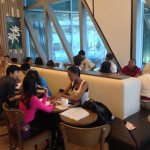
Starbucks in Jurong East
The truth was, it wasn’t much different. We found a Starbucks in the shopping center and had a coffee and a snack.
Around us were kids talking and studying their laptops and their assignments; much as you might find anywhere in the world. A European couple sat a few tables down from us absorbed in their conversation and not looking out of place at all. A boy and a girl were sitting and talking quietly near us and I thought they were in a new relationship by the way they looked at each other. No one was rowdy, no one was rude, and no one paid us the slightest attention. And the coffee was excellent.
We got back on the train and began the ride north. Along the way, we passed stations with catchy names like “Bukit Batok”, “Bukit Gombak”, “Choa Chu Kang” and “Yew Tee”.
It was a long and slow trip and the train was quite crowded at times. Outside, the scenery was always changing but, yet, always the same. High rises, parklands, industrial areas, and shopping centers. Only at one point on the northern journey did I see a bit of what might remain of the original rain forests that once filled the island. I read on-line that of the entire island, only 100 hectares of land remains in use for farming.
After awhile, the train’s rocking and the crowded spaces got to Colette and she felt a bit queasy so we got off and sat on a bench in a station, “Khatib”, I think. She felt better in 10 minutes or so and we got back onto the next train after that and completed the circuit back to our home station at Novena which is about a 15 minute walk from our hotel.

View from our room
Out hotel was nice and clean; though the room was a bit small. I liked it though because I could look directly out our window on the 9th floor and see a huge number of apartments in the 25 story apartment building just across from us. It was one of the more recently built buildings and I thought it compared favorably with the nice high rises we’d seen in Vancouver back in June.
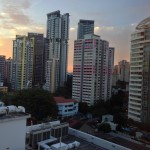
View from our hotel’s 9th floor
The next day, we played a bit and then, in the afternoon, we caught an overnight flight direct from Singapore to Christchurch which took 9 hours.
Singapore Airlines
Singapore had one last lesson to teach me; even as we were leaving. We flew out on Singapore Airlines and the service was very impressive and we were just flying in coach.
Most of the world’s airlines are caught in the “maximize profits and minimize costs” cycle which is an essential thing to do if, as a corporation, your bottom line is focused on maximizing the returns on investment for your shareholders.
Buying coach fare these days on most airlines is like riding in a third-world cattle car. If you get a nod and a small bag of peanuts, you should count yourself lucky.
It wasn’t like that on Singapore Airlines.

Singapore Airlines Menu
I realized it was going to be different when they came around with the menus. I was so impressed with getting a menu, I kept mine. First, they came around before we ate with hot cloths to clean your hands or to wipe your face. Then, we had a glass of wine before the meal was served. Then they served a nice meal which we chose from the menu. Later, during the night, as most of us slept or watched movies, they came around three times with apple juice to keep us hydrated and with snacks. In the morning, it was excellence again as they came around with another hot cloth before we ate breakfast.
I spent sometime on the flight wondering why, in a world in which all sorts of businesses seem to deliver less and less service for more and more money, why should Singapore Airlines be different. I think it may be a lack of greed.
Virtually all large corporate businesses are focused on maximizing the return on investment for their shareholders. The CEO’s of these companies keep their jobs if they can maximize profits and minimize costs and they are tossed out if they fail. And with huge pay packages and bonuses CEO get, they have a huge motivations to succeed. In truth, most corporations make so much money that the impact of these large pay packages is minuscule in the bigger picture.
But why is Singapore Airlines different? Singapore, the state, owns the majority of the stock of Singapore airlines. The state, through all the wise things it has done, is doing very well financially and it is also doing well with its goals to optimize the quality of life for its citizens.
Singapore, the country, doesn’t need to grind every last penny out of Singapore Airlines. In fact, it can afford the extra it costs to make the brand a quality brand by providing superior services for the money paid. And they know that’s going to be good in the long run for Singapore and all its citizens.
What I like about Singapore
There are no controlling shareholders who have to be appeased. If the airline makes money and runs in the black, then it is a success, it is good enough and it speaks well of the overall enterprise; Singapore. There is no need to squeeze it for more profit out of greed.
That’s a good deal of what I liked about Singapore. They clearly have the notion of Capitalism in hand. But they also get the idea of ‘enough’. More is not better; balance is better.
The people and the government of the place are doing well. It has the world’s 11th larger foreign reserves which is huge. Remember, this is a tiny city-state of only four to five million people.
Every 6th household in Singapore has more than a million dollars U.S. of disposable wealth. This doesn’t include property, businesses or luxury goods.
They are rated at the very top, along with New Zealand and the Scandinavian countries, as the least corrupt in the world.
The World Bank rated Singapore the easiest country in the world to do business in.
So, why, with the people and the government doing so very well, would they need to grind out more profit? They don’t; they understand ‘enough’ and ‘balance’. They are using Capitalism for their purposes and not letting it use them; as seems to be the case in so many other places.
Singapore has a game plan that puts the good of the population first and then harnesses Capitalism to serve that goal.
Well, after that little philosophical burst of enthusiasm on my part that probably gave a few conservative ‘me-me-me’ profit maximizing Capitalists a bit of heart burn, I think I’m going to wrap this long travel saga up.
End of the line
I’m back in Christchurch, New Zealand, now and settling in for awhile. Next year, in August, I will be able to get my New Zealand citizenship and I am looking forward to that.
Truly, folks, I see myself as an Internationalist. I don’t feel aligned with any particular country. I am aligned with what works; with what might make for a better world. I hope some of you will join me in thinking this way.
Cheers, from the end of the current road.
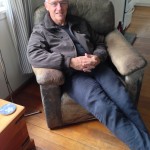
Home again for awhile
– 10Nov2013 – More on Singapore here: ➡
































